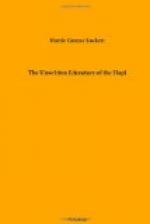[Footnote 20: Mindeleff, Cosmos, Traditional History of Tusayan (After A.M. Stephen): Bureau American Ethnology, vol. 8, pp. 16-41, 1887.]
In the beginning all men lived together in the lowest depths, in a region of darkness and moisture; their bodies were mis-shapen and horrible and they suffered great misery.
By appealing to Myuingwa (a vague conception of the god of the interior) and Baholinkonga (plumed serpent of enormous size, genius of water) their old men obtained a seed from which sprang a magic growth of cane.
The cane grew to miraculous height and penetrated through a crevice in the roof overhead and mankind climbed to a higher plane. Here was dim light and some vegetation. Another magic cane brought them to a higher plane, with more light and vegetation, and here was the creation of the animal kingdom. Singing was always the chief magic for creating anything. In like manner, they rose to the fourth stage or earth; some say by a pine tree, others say through the hollow cylinder of a great reed or rush.
This emergence was accompanied by singing, some say by the Magic Twins, the two little war gods, others say by the mocking bird. At any rate, it is important to observe that when the song ran out, no more people could get through and many had to remain behind.
However, the outlet through which man came has never been closed, and Myuingwa sends through it the germs of all living things. It is still symbolized, Stephen says, by the peculiar construction of the hatchway of the kiva, in designs on the kiva sand altars, and by the unconnected circle on pottery, basketry, and textiles. Doubtless the most direct representation of this opening to the underworld is the sipapu or ceremonial small round opening in the floor of the kiva, which all Hopi, without exception, agree symbolizes the opening or spirit passage to the underworld. “Out of the sipapu we all came,” they say, “and back to the underworld, through the sipapu, we shall go when we die.”
Once every year the Hopi hold an eight-day ceremony commemorating this emergence from the underworld. It is called the Wu-wu-che-ma, occurs in November and thus begins the series of Winter festivals. Four societies take part, and the Da-dow-Kiam or Mocking Bird Society opens the ceremony by singing into the kiva of the One-Horned Society this emergence song, the very song sung by the mocking bird at the original emergence, according to Voth.[21] This ceremony is a prayer to the powers of the underworld for prosperity and for germination of new life, human, animal, and vegetable. Fewkes called this the New Fire Ceremony, and in the course of the eight-day ceremonial the kindling of new fire with the primitive firestick does take place. But it is not hard to feel a close relation between the idea of fire and that of germination which stands out as the chief idea in the whole ritual, particularly in the subtle dramatization of the underworld life and emergence as carried on in the kivas, preceding the public “dance” on the last day.




